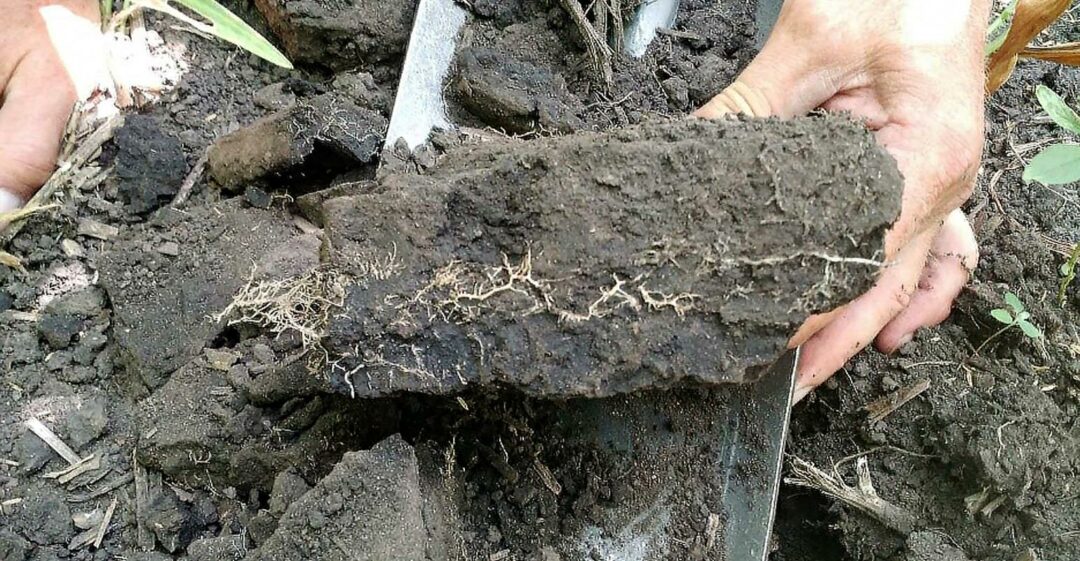By Jason Johnson, NRCS
 Soil science and agronomy professionals with USDA’s Natural Resources Conservation Service are advising Iowa farmers with crop damage from the Aug. 10 derecho that leaving their cropland soils undisturbed this fall and planting cover crops outweighs the costs of tillage.
Soil science and agronomy professionals with USDA’s Natural Resources Conservation Service are advising Iowa farmers with crop damage from the Aug. 10 derecho that leaving their cropland soils undisturbed this fall and planting cover crops outweighs the costs of tillage.
Mike Henderson, state agronomist with NRCS in Des Moines, says it is relatively simple to calculate the time and financial costs associated with tillage, but the long-term damage to the structure and biology in the soil is much harder to account for. He says tillage negatively impacts soil structure, organic matter, habitat and compaction:
Soil structure. A healthy soil structure provides the framework for good water infiltration, reduced runoff and root development.
Organic matter. Tillage promotes “burning” of organic matter. The amount of organic matter in the soil is a primary indicator of peak-performing soil. Tillage aerates the soil, triggering increased biological activity, which results in rapid decomposition, loss of soil organic matter and release of carbon dioxide into the atmosphere.
Habitat. Tillage can destroy the soil structure needed for good habitat for the microorganisms living in the soil. Most of these organisms live in the top 2 inches of the soil surface, so even the shallowest tillage operations have damaging effects. These microorganisms play an important role in nutrient cycling and helping to decompose organic matter.
Compaction. Tillage can damage soil structure making it more vulnerable to compaction. Compaction reduces the amount of air, water and space available to roots and soil organisms. When this space is removed, runoff increases, and root development and fertility decrease.
“Soil compaction is particularly evident when you use a disk or vertical tillage implement,” Henderson says. “The weight of the machine and any soil it is lifting during the operation is concentrated on the edge of the blade, creating a layer of compacted soil at the depth of tillage.”
Pictured Above: SOIL COMPACTION. Proliferation of roots along a compaction layer 2 inches deep shows the inability of the roots to penetrate deeper into the soil profile.
Reduced C:N Ratio Helps
Henderson says corn residue in downed corn will be more susceptible to decomposition. “Corn that was root-lodged, green snapped or with pinched stalks will have reduced resources to reach full maturity,” he says. “The stalks will be cannibalized by the plant to put all remaining resources into kernel development.”
The impact will be a reduction in the carbon-to-nitrogen ratio of the corn residue, which in turn will allow the soil biology to break it down faster than in a normal year. “Since stalks and leaves will be in contact with the soil longer this fall due to a lower C:N ratio, it is likely to have less crop residue to manage next spring than in a normal year,” he says. “Tillage will accelerate the decomposition to a point that little to no residue will remain through planting next spring. This will expose the soil to additional degradation and crusting, and potentially impact conservation compliance on HEL [highly erodible land] fields.”
Alternative ways to deal with volunteer corn include leaving the ear intact and on the surface, or breaking the ear open to encourage germination. “Both methods have pros and cons for managing volunteer corn,” he says.
No-Till vs. Tillage
With no-till, leaving the ear intact on top of the ground will expose it to bacterial and fungal rot and predation. Along with fewer kernels surviving until spring, the ear placement will limit the number of kernels that will germinate to the bottom rows of kernels on the ear. The root from these kernels will struggle to penetrate the husk, severely limiting the vigor of the seedling corn.
No-Till Has Advantages. University of Minnesota Extension agronomists recommend no-till as a way of managing downed corn. In Managing the Potential for Volunteer Corn in 2019, they state, “No-till extends the benefit of no fall tillage. By not incorporating seed into the soil, it is left on the soil surface where it is much less likely to result in successful germination and emergence.”
Managing volunteer corn with a sound pest management program can be very effective when going to soybeans, Henderson says. “If farmers are considering planting corn again next year on those acres, use a different herbicide trait than the volunteer corn to better control any unwanted establishment,” he advises.
Tillage Has Drawbacks. If damage to the soil structure, organic matter and biology is not considered, Henderson says tilling or disking the soil will enhance the amount of volunteer corn by breaking the ear up and putting the kernels of corn in contact with soil.
“Tilling early in the fall will allow some of the corn kernels to germinate, once they have reached physiological maturity and dried down,” he says. “However, not all kernels will germinate this fall, leading to a flush of volunteer corn next spring once the soil warms enough for germination. Managing volunteer corn will then require a sound pest management program for effective control.”
In addition to volunteer corn control, NRCS is also promoting no-till post-derecho for soil health reasons. The photo above was taken in a field that has been vertical-tilled for several years in a corn-soybean rotation. Proliferation of roots along the compaction layer 2 inches deep shows the inability of the roots to penetrate deeper into the soil profile. This severely limits the ability of the soybean plant to take up moisture and nutrients.
If you are interested in learning more about ways to manage damaged crops, including cover crop selection and application methods, email Mike Henderson at michael.henderson@usda.gov
Johnson is state public affairs specialist for USDA Natural Resources Conservation Service, Des Moines, Iowa.






